Qantas Monopoly Power: Inefficiencies and Government Intervention
VerifiedAdded on 2023/04/20
|11
|2374
|182
Essay
AI Summary
This essay analyzes the monopoly power of Qantas in the Australian aviation industry. It begins by defining monopoly and explaining how Qantas exhibits significant market dominance. The essay then identifies the inefficiencies that arise from Qantas' monopoly power, such as higher prices, reduced output, and deadweight welfare loss, supported by graphical representations. The analysis covers Qantas' advantages from monopoly power, including innovation and economies of scale. The study further explores how government intervention, specifically price capping regulation, market liberalization, and merger policies, can be used to curb Qantas' monopoly power and promote a more efficient outcome for the economy. The essay concludes by summarizing the key findings regarding Qantas' monopoly power, its impact, and the government's role in regulating the industry. This essay provides a comprehensive overview of the economic principles and their application in the context of Qantas' market position and the government's regulatory responses.
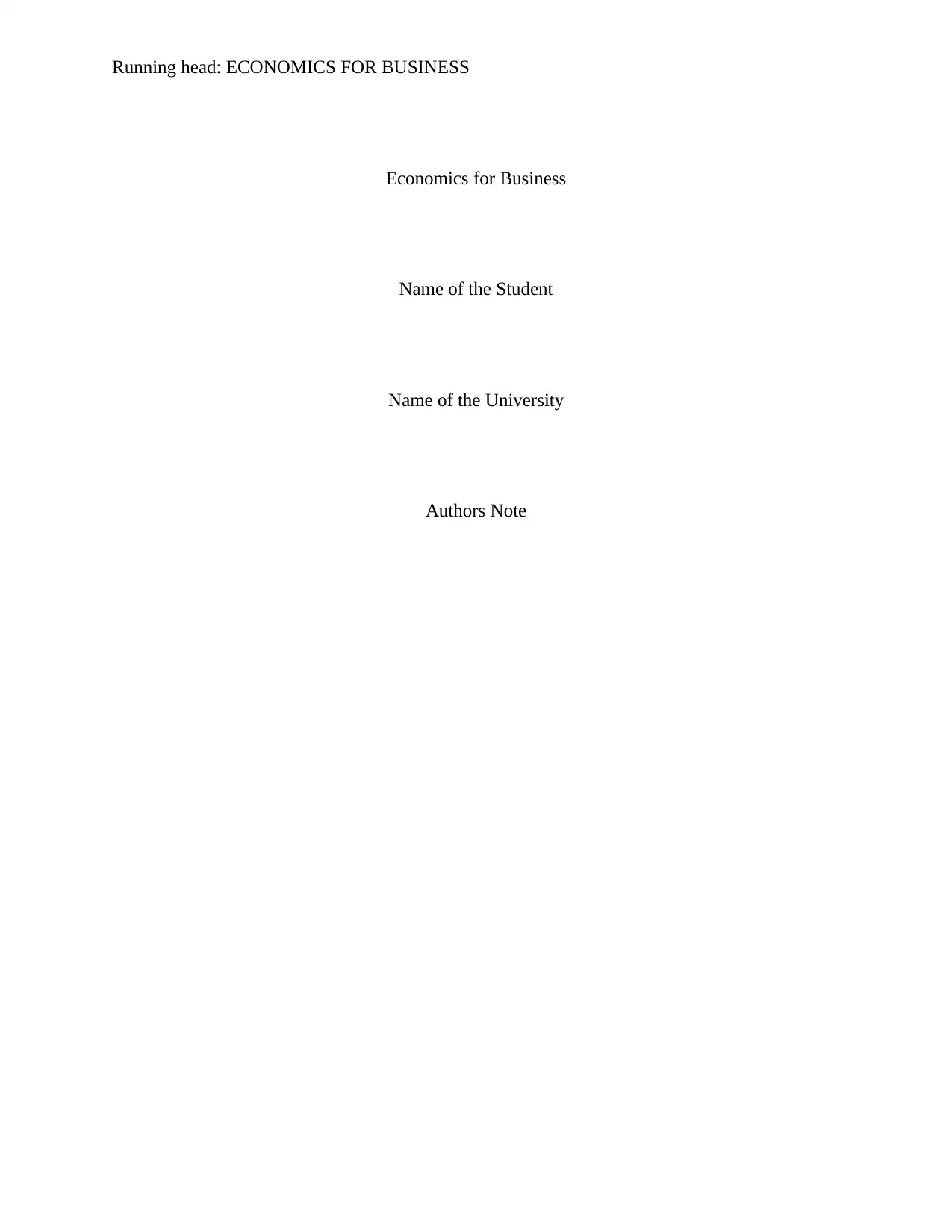
Running head: ECONOMICS FOR BUSINESS
Economics for Business
Name of the Student
Name of the University
Authors Note
Economics for Business
Name of the Student
Name of the University
Authors Note
Paraphrase This Document
Need a fresh take? Get an instant paraphrase of this document with our AI Paraphraser
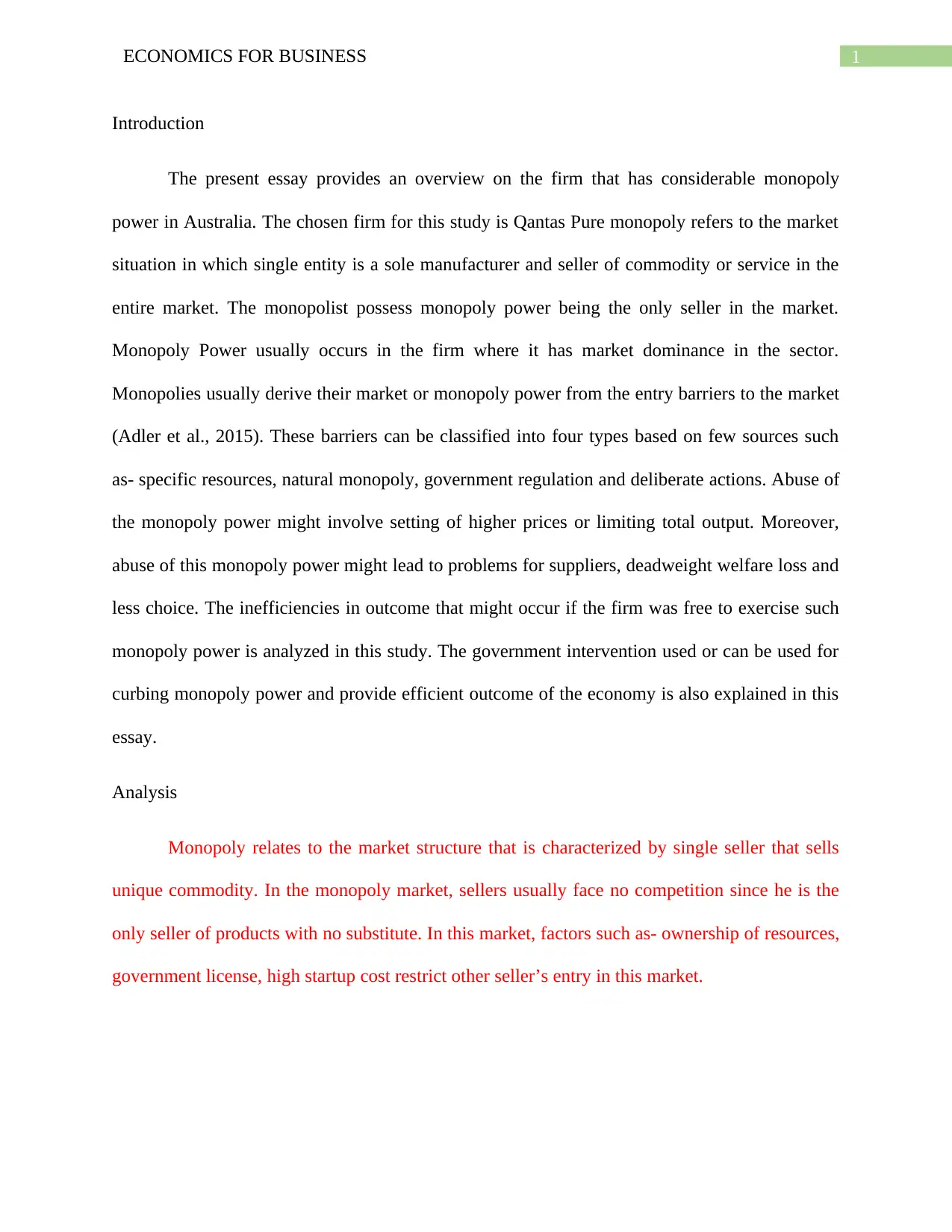
1ECONOMICS FOR BUSINESS
Introduction
The present essay provides an overview on the firm that has considerable monopoly
power in Australia. The chosen firm for this study is Qantas Pure monopoly refers to the market
situation in which single entity is a sole manufacturer and seller of commodity or service in the
entire market. The monopolist possess monopoly power being the only seller in the market.
Monopoly Power usually occurs in the firm where it has market dominance in the sector.
Monopolies usually derive their market or monopoly power from the entry barriers to the market
(Adler et al., 2015). These barriers can be classified into four types based on few sources such
as- specific resources, natural monopoly, government regulation and deliberate actions. Abuse of
the monopoly power might involve setting of higher prices or limiting total output. Moreover,
abuse of this monopoly power might lead to problems for suppliers, deadweight welfare loss and
less choice. The inefficiencies in outcome that might occur if the firm was free to exercise such
monopoly power is analyzed in this study. The government intervention used or can be used for
curbing monopoly power and provide efficient outcome of the economy is also explained in this
essay.
Analysis
Monopoly relates to the market structure that is characterized by single seller that sells
unique commodity. In the monopoly market, sellers usually face no competition since he is the
only seller of products with no substitute. In this market, factors such as- ownership of resources,
government license, high startup cost restrict other seller’s entry in this market.
Introduction
The present essay provides an overview on the firm that has considerable monopoly
power in Australia. The chosen firm for this study is Qantas Pure monopoly refers to the market
situation in which single entity is a sole manufacturer and seller of commodity or service in the
entire market. The monopolist possess monopoly power being the only seller in the market.
Monopoly Power usually occurs in the firm where it has market dominance in the sector.
Monopolies usually derive their market or monopoly power from the entry barriers to the market
(Adler et al., 2015). These barriers can be classified into four types based on few sources such
as- specific resources, natural monopoly, government regulation and deliberate actions. Abuse of
the monopoly power might involve setting of higher prices or limiting total output. Moreover,
abuse of this monopoly power might lead to problems for suppliers, deadweight welfare loss and
less choice. The inefficiencies in outcome that might occur if the firm was free to exercise such
monopoly power is analyzed in this study. The government intervention used or can be used for
curbing monopoly power and provide efficient outcome of the economy is also explained in this
essay.
Analysis
Monopoly relates to the market structure that is characterized by single seller that sells
unique commodity. In the monopoly market, sellers usually face no competition since he is the
only seller of products with no substitute. In this market, factors such as- ownership of resources,
government license, high startup cost restrict other seller’s entry in this market.
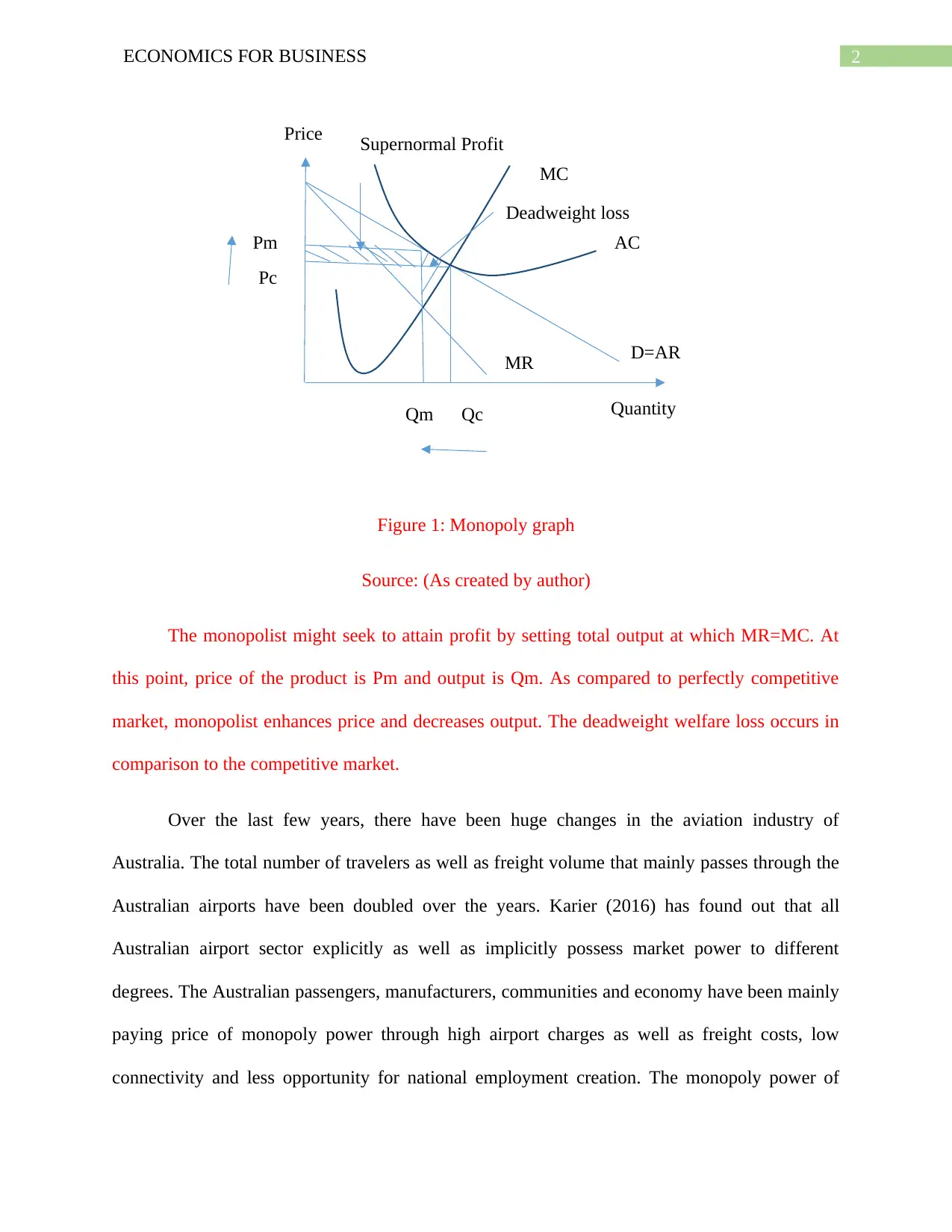
2ECONOMICS FOR BUSINESS
D=AR
MR
AC
MC
Quantity
Price
QcQm
Pc
Pm
Deadweight loss
Supernormal Profit
Figure 1: Monopoly graph
Source: (As created by author)
The monopolist might seek to attain profit by setting total output at which MR=MC. At
this point, price of the product is Pm and output is Qm. As compared to perfectly competitive
market, monopolist enhances price and decreases output. The deadweight welfare loss occurs in
comparison to the competitive market.
Over the last few years, there have been huge changes in the aviation industry of
Australia. The total number of travelers as well as freight volume that mainly passes through the
Australian airports have been doubled over the years. Karier (2016) has found out that all
Australian airport sector explicitly as well as implicitly possess market power to different
degrees. The Australian passengers, manufacturers, communities and economy have been mainly
paying price of monopoly power through high airport charges as well as freight costs, low
connectivity and less opportunity for national employment creation. The monopoly power of
D=AR
MR
AC
MC
Quantity
Price
QcQm
Pc
Pm
Deadweight loss
Supernormal Profit
Figure 1: Monopoly graph
Source: (As created by author)
The monopolist might seek to attain profit by setting total output at which MR=MC. At
this point, price of the product is Pm and output is Qm. As compared to perfectly competitive
market, monopolist enhances price and decreases output. The deadweight welfare loss occurs in
comparison to the competitive market.
Over the last few years, there have been huge changes in the aviation industry of
Australia. The total number of travelers as well as freight volume that mainly passes through the
Australian airports have been doubled over the years. Karier (2016) has found out that all
Australian airport sector explicitly as well as implicitly possess market power to different
degrees. The Australian passengers, manufacturers, communities and economy have been mainly
paying price of monopoly power through high airport charges as well as freight costs, low
connectivity and less opportunity for national employment creation. The monopoly power of
⊘ This is a preview!⊘
Do you want full access?
Subscribe today to unlock all pages.

Trusted by 1+ million students worldwide
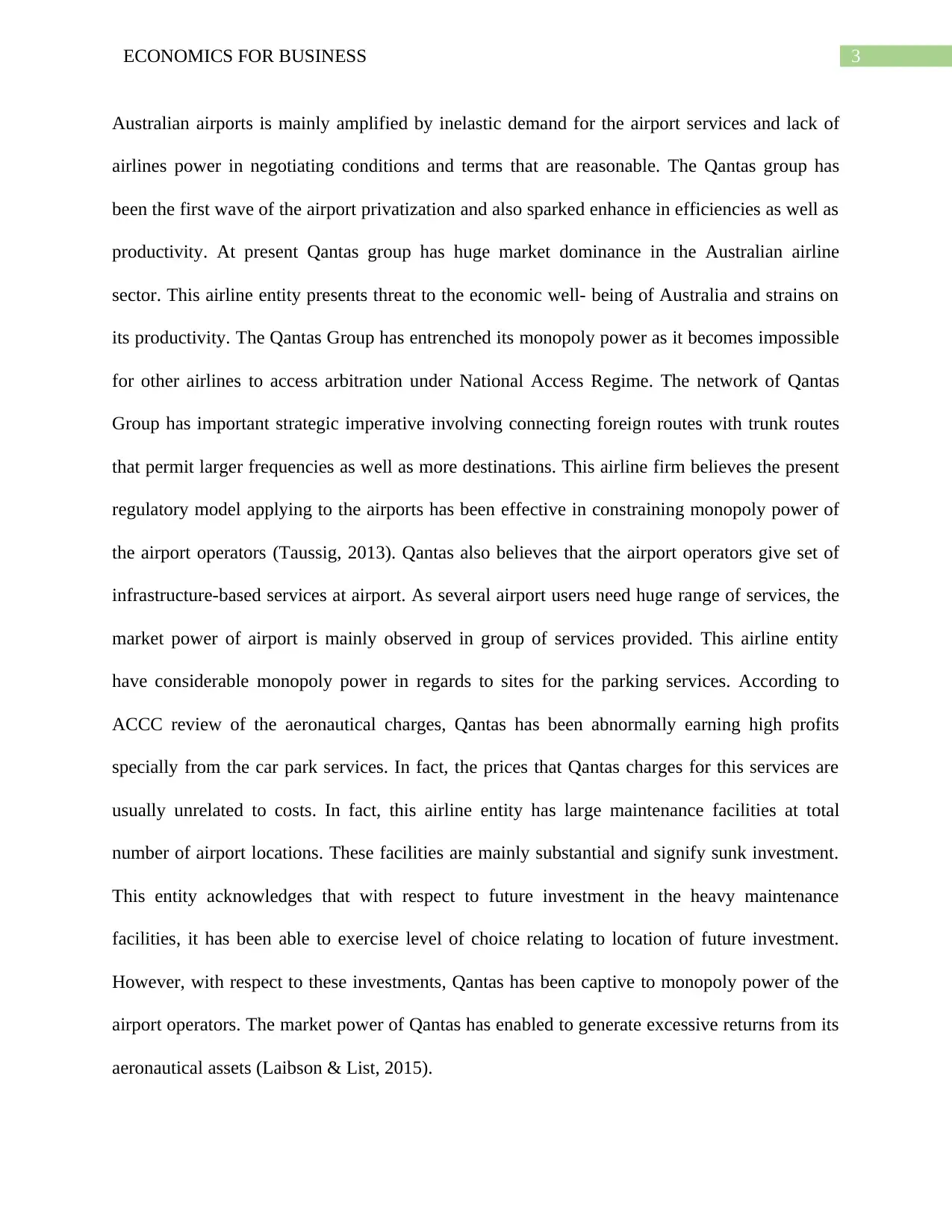
3ECONOMICS FOR BUSINESS
Australian airports is mainly amplified by inelastic demand for the airport services and lack of
airlines power in negotiating conditions and terms that are reasonable. The Qantas group has
been the first wave of the airport privatization and also sparked enhance in efficiencies as well as
productivity. At present Qantas group has huge market dominance in the Australian airline
sector. This airline entity presents threat to the economic well- being of Australia and strains on
its productivity. The Qantas Group has entrenched its monopoly power as it becomes impossible
for other airlines to access arbitration under National Access Regime. The network of Qantas
Group has important strategic imperative involving connecting foreign routes with trunk routes
that permit larger frequencies as well as more destinations. This airline firm believes the present
regulatory model applying to the airports has been effective in constraining monopoly power of
the airport operators (Taussig, 2013). Qantas also believes that the airport operators give set of
infrastructure-based services at airport. As several airport users need huge range of services, the
market power of airport is mainly observed in group of services provided. This airline entity
have considerable monopoly power in regards to sites for the parking services. According to
ACCC review of the aeronautical charges, Qantas has been abnormally earning high profits
specially from the car park services. In fact, the prices that Qantas charges for this services are
usually unrelated to costs. In fact, this airline entity has large maintenance facilities at total
number of airport locations. These facilities are mainly substantial and signify sunk investment.
This entity acknowledges that with respect to future investment in the heavy maintenance
facilities, it has been able to exercise level of choice relating to location of future investment.
However, with respect to these investments, Qantas has been captive to monopoly power of the
airport operators. The market power of Qantas has enabled to generate excessive returns from its
aeronautical assets (Laibson & List, 2015).
Australian airports is mainly amplified by inelastic demand for the airport services and lack of
airlines power in negotiating conditions and terms that are reasonable. The Qantas group has
been the first wave of the airport privatization and also sparked enhance in efficiencies as well as
productivity. At present Qantas group has huge market dominance in the Australian airline
sector. This airline entity presents threat to the economic well- being of Australia and strains on
its productivity. The Qantas Group has entrenched its monopoly power as it becomes impossible
for other airlines to access arbitration under National Access Regime. The network of Qantas
Group has important strategic imperative involving connecting foreign routes with trunk routes
that permit larger frequencies as well as more destinations. This airline firm believes the present
regulatory model applying to the airports has been effective in constraining monopoly power of
the airport operators (Taussig, 2013). Qantas also believes that the airport operators give set of
infrastructure-based services at airport. As several airport users need huge range of services, the
market power of airport is mainly observed in group of services provided. This airline entity
have considerable monopoly power in regards to sites for the parking services. According to
ACCC review of the aeronautical charges, Qantas has been abnormally earning high profits
specially from the car park services. In fact, the prices that Qantas charges for this services are
usually unrelated to costs. In fact, this airline entity has large maintenance facilities at total
number of airport locations. These facilities are mainly substantial and signify sunk investment.
This entity acknowledges that with respect to future investment in the heavy maintenance
facilities, it has been able to exercise level of choice relating to location of future investment.
However, with respect to these investments, Qantas has been captive to monopoly power of the
airport operators. The market power of Qantas has enabled to generate excessive returns from its
aeronautical assets (Laibson & List, 2015).
Paraphrase This Document
Need a fresh take? Get an instant paraphrase of this document with our AI Paraphraser
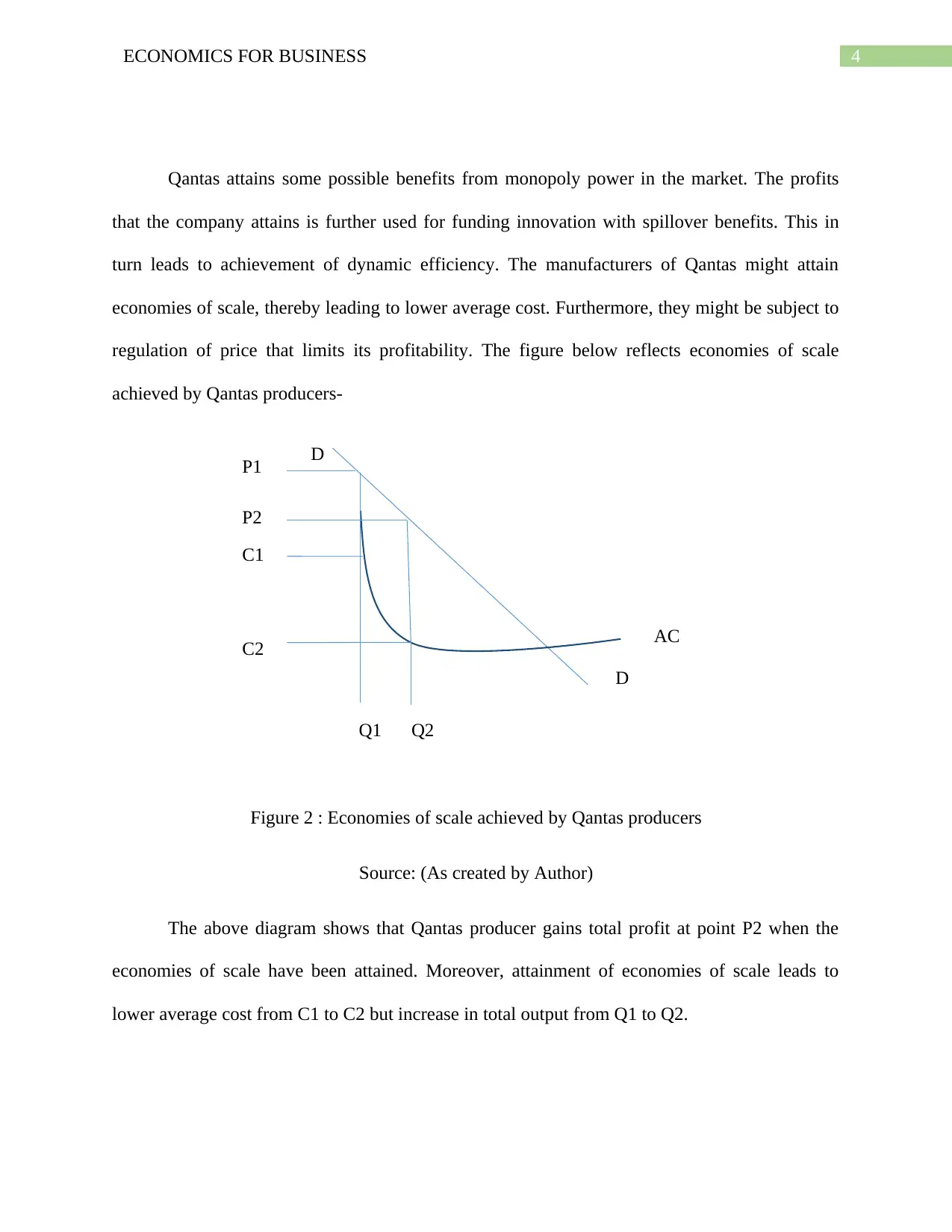
4ECONOMICS FOR BUSINESS
D
D
AC
Q2Q1
C2
C1
P2
P1
Qantas attains some possible benefits from monopoly power in the market. The profits
that the company attains is further used for funding innovation with spillover benefits. This in
turn leads to achievement of dynamic efficiency. The manufacturers of Qantas might attain
economies of scale, thereby leading to lower average cost. Furthermore, they might be subject to
regulation of price that limits its profitability. The figure below reflects economies of scale
achieved by Qantas producers-
Figure 2 : Economies of scale achieved by Qantas producers
Source: (As created by Author)
The above diagram shows that Qantas producer gains total profit at point P2 when the
economies of scale have been attained. Moreover, attainment of economies of scale leads to
lower average cost from C1 to C2 but increase in total output from Q1 to Q2.
D
D
AC
Q2Q1
C2
C1
P2
P1
Qantas attains some possible benefits from monopoly power in the market. The profits
that the company attains is further used for funding innovation with spillover benefits. This in
turn leads to achievement of dynamic efficiency. The manufacturers of Qantas might attain
economies of scale, thereby leading to lower average cost. Furthermore, they might be subject to
regulation of price that limits its profitability. The figure below reflects economies of scale
achieved by Qantas producers-
Figure 2 : Economies of scale achieved by Qantas producers
Source: (As created by Author)
The above diagram shows that Qantas producer gains total profit at point P2 when the
economies of scale have been attained. Moreover, attainment of economies of scale leads to
lower average cost from C1 to C2 but increase in total output from Q1 to Q2.
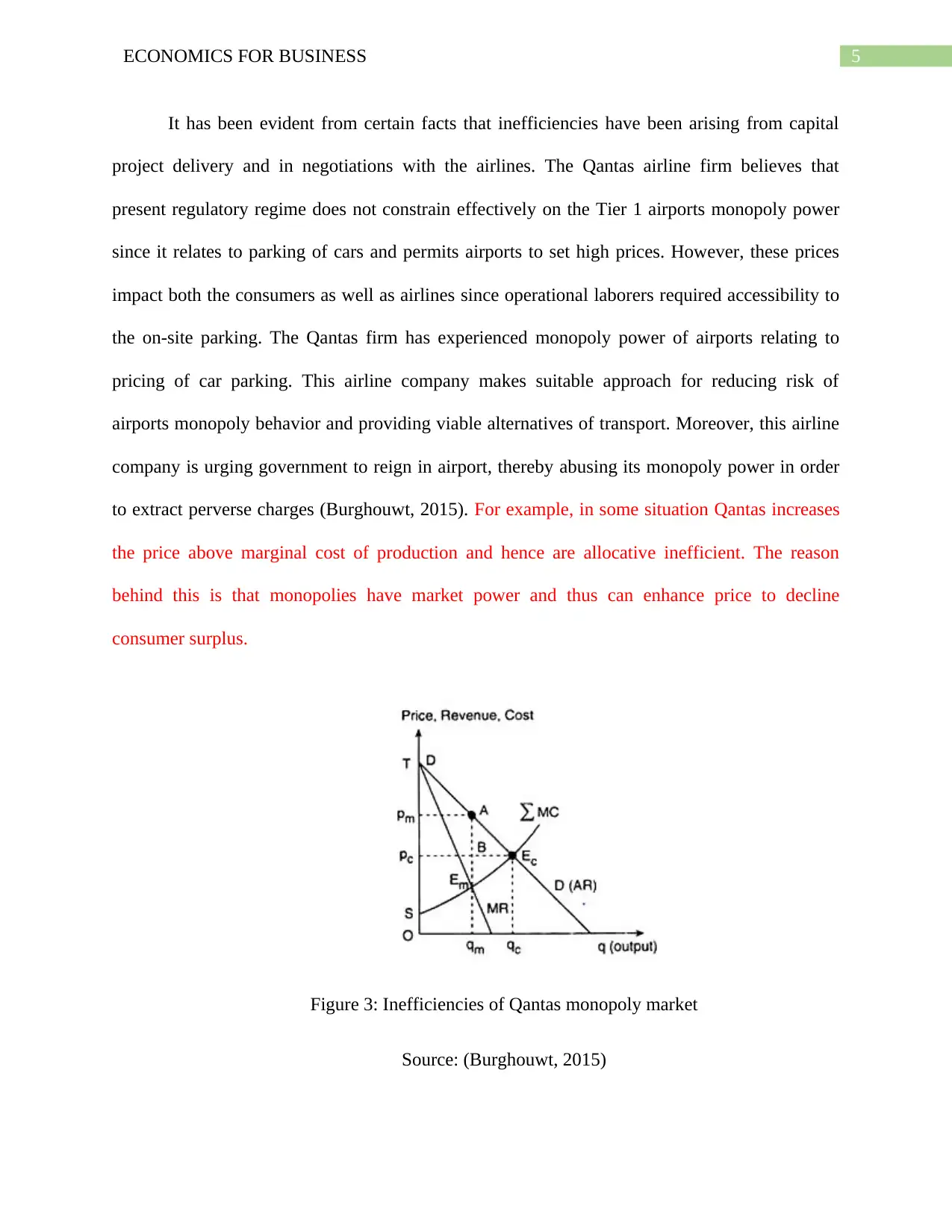
5ECONOMICS FOR BUSINESS
It has been evident from certain facts that inefficiencies have been arising from capital
project delivery and in negotiations with the airlines. The Qantas airline firm believes that
present regulatory regime does not constrain effectively on the Tier 1 airports monopoly power
since it relates to parking of cars and permits airports to set high prices. However, these prices
impact both the consumers as well as airlines since operational laborers required accessibility to
the on-site parking. The Qantas firm has experienced monopoly power of airports relating to
pricing of car parking. This airline company makes suitable approach for reducing risk of
airports monopoly behavior and providing viable alternatives of transport. Moreover, this airline
company is urging government to reign in airport, thereby abusing its monopoly power in order
to extract perverse charges (Burghouwt, 2015). For example, in some situation Qantas increases
the price above marginal cost of production and hence are allocative inefficient. The reason
behind this is that monopolies have market power and thus can enhance price to decline
consumer surplus.
Figure 3: Inefficiencies of Qantas monopoly market
Source: (Burghouwt, 2015)
It has been evident from certain facts that inefficiencies have been arising from capital
project delivery and in negotiations with the airlines. The Qantas airline firm believes that
present regulatory regime does not constrain effectively on the Tier 1 airports monopoly power
since it relates to parking of cars and permits airports to set high prices. However, these prices
impact both the consumers as well as airlines since operational laborers required accessibility to
the on-site parking. The Qantas firm has experienced monopoly power of airports relating to
pricing of car parking. This airline company makes suitable approach for reducing risk of
airports monopoly behavior and providing viable alternatives of transport. Moreover, this airline
company is urging government to reign in airport, thereby abusing its monopoly power in order
to extract perverse charges (Burghouwt, 2015). For example, in some situation Qantas increases
the price above marginal cost of production and hence are allocative inefficient. The reason
behind this is that monopolies have market power and thus can enhance price to decline
consumer surplus.
Figure 3: Inefficiencies of Qantas monopoly market
Source: (Burghouwt, 2015)
⊘ This is a preview!⊘
Do you want full access?
Subscribe today to unlock all pages.

Trusted by 1+ million students worldwide
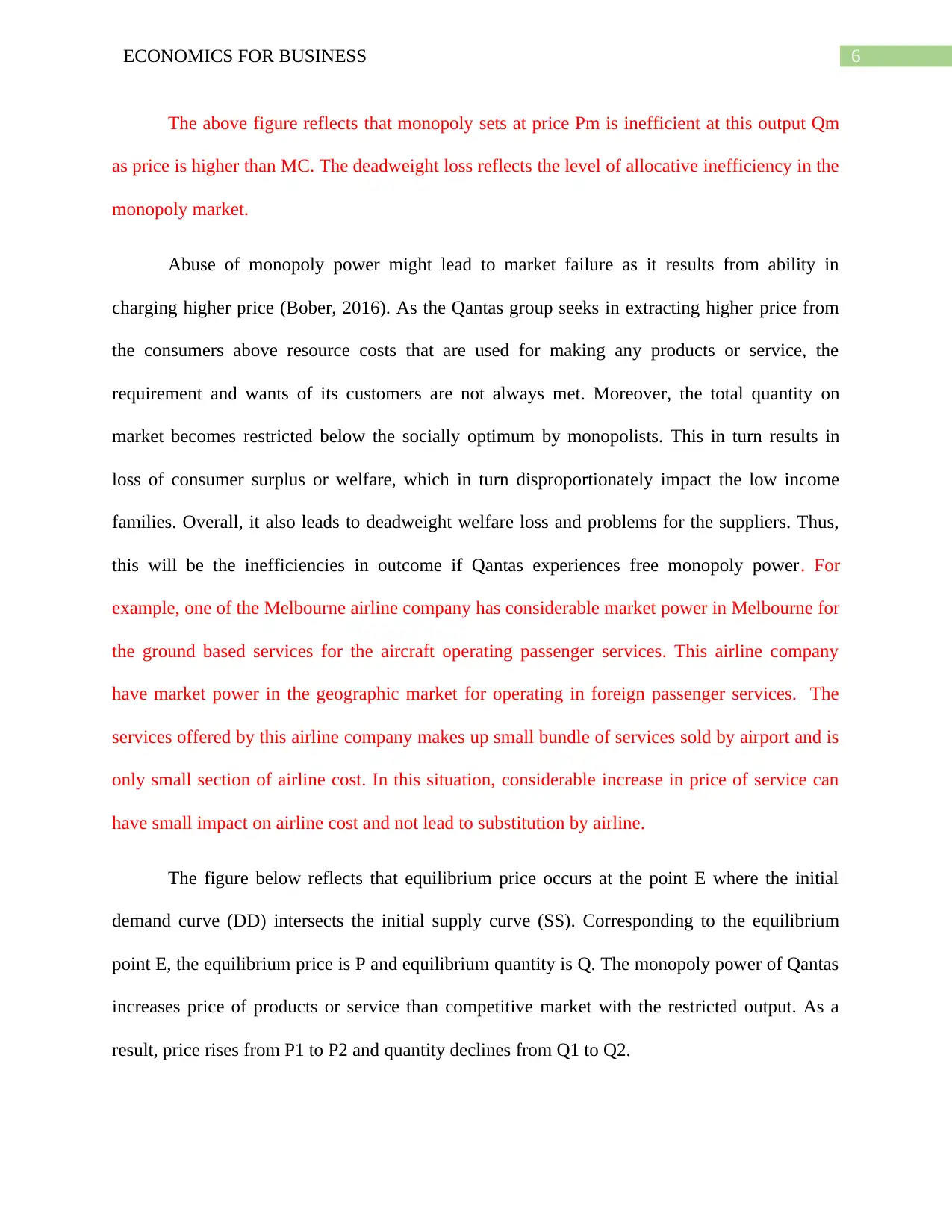
6ECONOMICS FOR BUSINESS
The above figure reflects that monopoly sets at price Pm is inefficient at this output Qm
as price is higher than MC. The deadweight loss reflects the level of allocative inefficiency in the
monopoly market.
Abuse of monopoly power might lead to market failure as it results from ability in
charging higher price (Bober, 2016). As the Qantas group seeks in extracting higher price from
the consumers above resource costs that are used for making any products or service, the
requirement and wants of its customers are not always met. Moreover, the total quantity on
market becomes restricted below the socially optimum by monopolists. This in turn results in
loss of consumer surplus or welfare, which in turn disproportionately impact the low income
families. Overall, it also leads to deadweight welfare loss and problems for the suppliers. Thus,
this will be the inefficiencies in outcome if Qantas experiences free monopoly power. For
example, one of the Melbourne airline company has considerable market power in Melbourne for
the ground based services for the aircraft operating passenger services. This airline company
have market power in the geographic market for operating in foreign passenger services. The
services offered by this airline company makes up small bundle of services sold by airport and is
only small section of airline cost. In this situation, considerable increase in price of service can
have small impact on airline cost and not lead to substitution by airline.
The figure below reflects that equilibrium price occurs at the point E where the initial
demand curve (DD) intersects the initial supply curve (SS). Corresponding to the equilibrium
point E, the equilibrium price is P and equilibrium quantity is Q. The monopoly power of Qantas
increases price of products or service than competitive market with the restricted output. As a
result, price rises from P1 to P2 and quantity declines from Q1 to Q2.
The above figure reflects that monopoly sets at price Pm is inefficient at this output Qm
as price is higher than MC. The deadweight loss reflects the level of allocative inefficiency in the
monopoly market.
Abuse of monopoly power might lead to market failure as it results from ability in
charging higher price (Bober, 2016). As the Qantas group seeks in extracting higher price from
the consumers above resource costs that are used for making any products or service, the
requirement and wants of its customers are not always met. Moreover, the total quantity on
market becomes restricted below the socially optimum by monopolists. This in turn results in
loss of consumer surplus or welfare, which in turn disproportionately impact the low income
families. Overall, it also leads to deadweight welfare loss and problems for the suppliers. Thus,
this will be the inefficiencies in outcome if Qantas experiences free monopoly power. For
example, one of the Melbourne airline company has considerable market power in Melbourne for
the ground based services for the aircraft operating passenger services. This airline company
have market power in the geographic market for operating in foreign passenger services. The
services offered by this airline company makes up small bundle of services sold by airport and is
only small section of airline cost. In this situation, considerable increase in price of service can
have small impact on airline cost and not lead to substitution by airline.
The figure below reflects that equilibrium price occurs at the point E where the initial
demand curve (DD) intersects the initial supply curve (SS). Corresponding to the equilibrium
point E, the equilibrium price is P and equilibrium quantity is Q. The monopoly power of Qantas
increases price of products or service than competitive market with the restricted output. As a
result, price rises from P1 to P2 and quantity declines from Q1 to Q2.
Paraphrase This Document
Need a fresh take? Get an instant paraphrase of this document with our AI Paraphraser
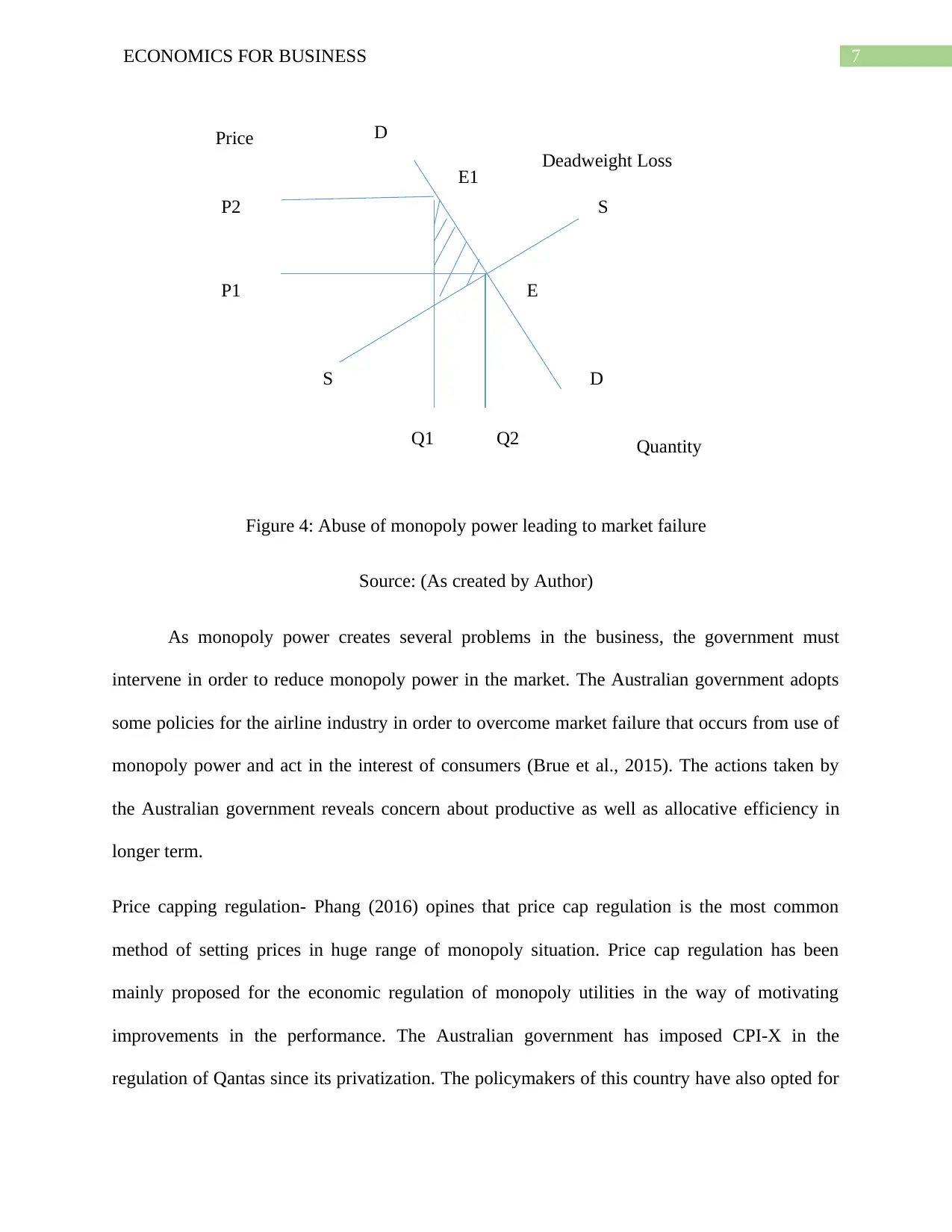
7ECONOMICS FOR BUSINESS
Quantity
Price
D
D
S
S
P1
P2
Q1 Q2
Deadweight Loss
E
E1
Figure 4: Abuse of monopoly power leading to market failure
Source: (As created by Author)
As monopoly power creates several problems in the business, the government must
intervene in order to reduce monopoly power in the market. The Australian government adopts
some policies for the airline industry in order to overcome market failure that occurs from use of
monopoly power and act in the interest of consumers (Brue et al., 2015). The actions taken by
the Australian government reveals concern about productive as well as allocative efficiency in
longer term.
Price capping regulation- Phang (2016) opines that price cap regulation is the most common
method of setting prices in huge range of monopoly situation. Price cap regulation has been
mainly proposed for the economic regulation of monopoly utilities in the way of motivating
improvements in the performance. The Australian government has imposed CPI-X in the
regulation of Qantas since its privatization. The policymakers of this country have also opted for
Quantity
Price
D
D
S
S
P1
P2
Q1 Q2
Deadweight Loss
E
E1
Figure 4: Abuse of monopoly power leading to market failure
Source: (As created by Author)
As monopoly power creates several problems in the business, the government must
intervene in order to reduce monopoly power in the market. The Australian government adopts
some policies for the airline industry in order to overcome market failure that occurs from use of
monopoly power and act in the interest of consumers (Brue et al., 2015). The actions taken by
the Australian government reveals concern about productive as well as allocative efficiency in
longer term.
Price capping regulation- Phang (2016) opines that price cap regulation is the most common
method of setting prices in huge range of monopoly situation. Price cap regulation has been
mainly proposed for the economic regulation of monopoly utilities in the way of motivating
improvements in the performance. The Australian government has imposed CPI-X in the
regulation of Qantas since its privatization. The policymakers of this country have also opted for
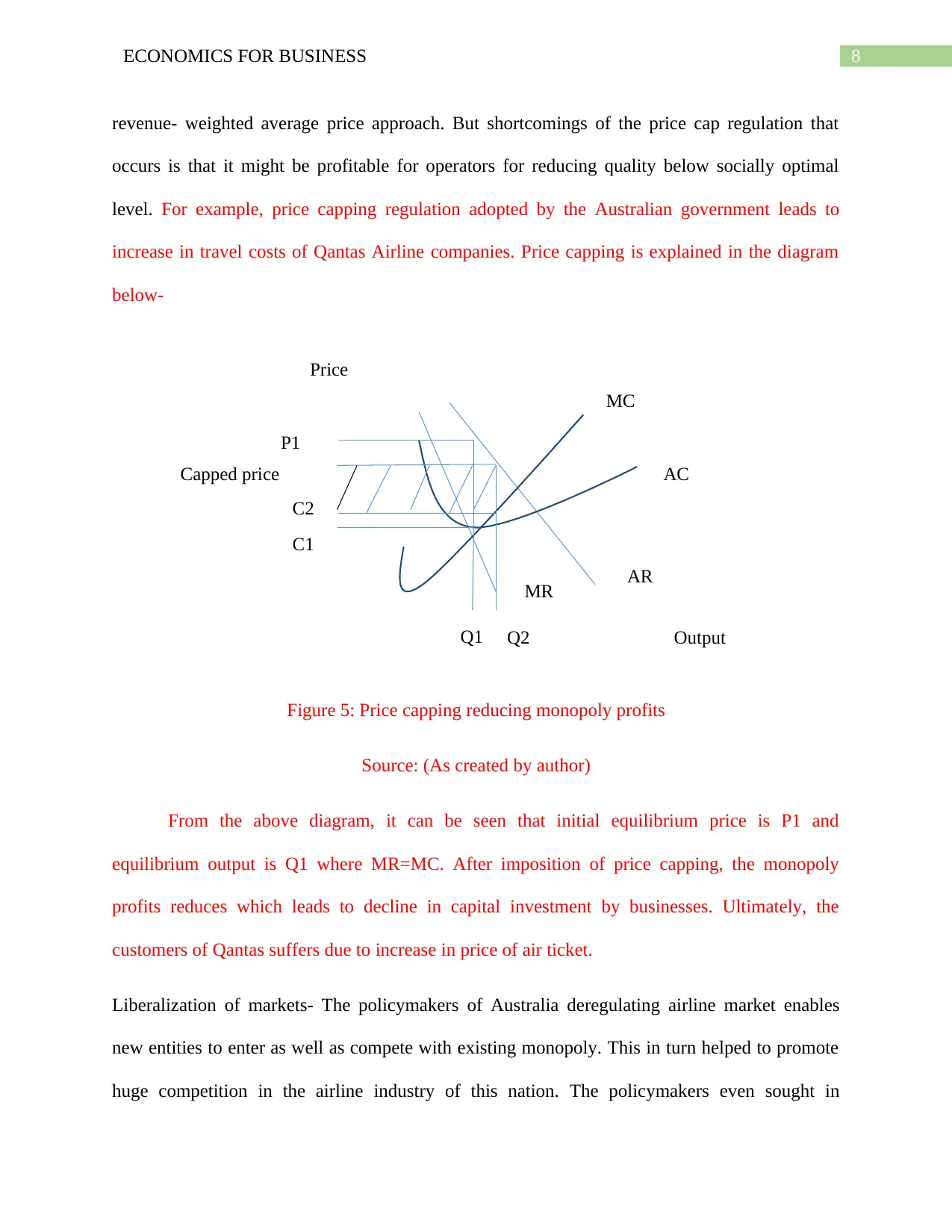
8ECONOMICS FOR BUSINESS
Q2Q1
C1
P1
Capped price
C2
AR
MR
MC
AC
Output
Price
revenue- weighted average price approach. But shortcomings of the price cap regulation that
occurs is that it might be profitable for operators for reducing quality below socially optimal
level. For example, price capping regulation adopted by the Australian government leads to
increase in travel costs of Qantas Airline companies. Price capping is explained in the diagram
below-
Figure 5: Price capping reducing monopoly profits
Source: (As created by author)
From the above diagram, it can be seen that initial equilibrium price is P1 and
equilibrium output is Q1 where MR=MC. After imposition of price capping, the monopoly
profits reduces which leads to decline in capital investment by businesses. Ultimately, the
customers of Qantas suffers due to increase in price of air ticket.
Liberalization of markets- The policymakers of Australia deregulating airline market enables
new entities to enter as well as compete with existing monopoly. This in turn helped to promote
huge competition in the airline industry of this nation. The policymakers even sought in
Q2Q1
C1
P1
Capped price
C2
AR
MR
MC
AC
Output
Price
revenue- weighted average price approach. But shortcomings of the price cap regulation that
occurs is that it might be profitable for operators for reducing quality below socially optimal
level. For example, price capping regulation adopted by the Australian government leads to
increase in travel costs of Qantas Airline companies. Price capping is explained in the diagram
below-
Figure 5: Price capping reducing monopoly profits
Source: (As created by author)
From the above diagram, it can be seen that initial equilibrium price is P1 and
equilibrium output is Q1 where MR=MC. After imposition of price capping, the monopoly
profits reduces which leads to decline in capital investment by businesses. Ultimately, the
customers of Qantas suffers due to increase in price of air ticket.
Liberalization of markets- The policymakers of Australia deregulating airline market enables
new entities to enter as well as compete with existing monopoly. This in turn helped to promote
huge competition in the airline industry of this nation. The policymakers even sought in
⊘ This is a preview!⊘
Do you want full access?
Subscribe today to unlock all pages.

Trusted by 1+ million students worldwide
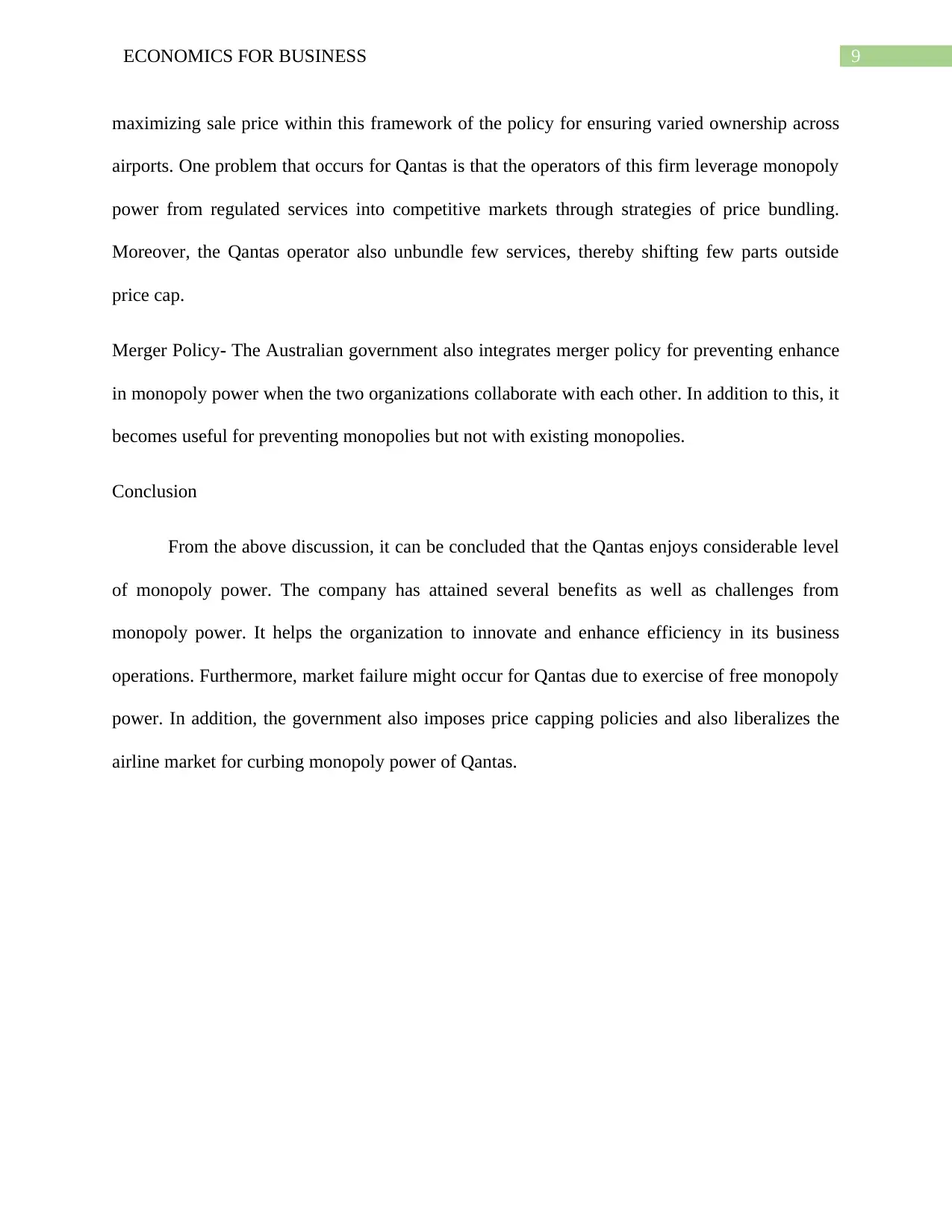
9ECONOMICS FOR BUSINESS
maximizing sale price within this framework of the policy for ensuring varied ownership across
airports. One problem that occurs for Qantas is that the operators of this firm leverage monopoly
power from regulated services into competitive markets through strategies of price bundling.
Moreover, the Qantas operator also unbundle few services, thereby shifting few parts outside
price cap.
Merger Policy- The Australian government also integrates merger policy for preventing enhance
in monopoly power when the two organizations collaborate with each other. In addition to this, it
becomes useful for preventing monopolies but not with existing monopolies.
Conclusion
From the above discussion, it can be concluded that the Qantas enjoys considerable level
of monopoly power. The company has attained several benefits as well as challenges from
monopoly power. It helps the organization to innovate and enhance efficiency in its business
operations. Furthermore, market failure might occur for Qantas due to exercise of free monopoly
power. In addition, the government also imposes price capping policies and also liberalizes the
airline market for curbing monopoly power of Qantas.
maximizing sale price within this framework of the policy for ensuring varied ownership across
airports. One problem that occurs for Qantas is that the operators of this firm leverage monopoly
power from regulated services into competitive markets through strategies of price bundling.
Moreover, the Qantas operator also unbundle few services, thereby shifting few parts outside
price cap.
Merger Policy- The Australian government also integrates merger policy for preventing enhance
in monopoly power when the two organizations collaborate with each other. In addition to this, it
becomes useful for preventing monopolies but not with existing monopolies.
Conclusion
From the above discussion, it can be concluded that the Qantas enjoys considerable level
of monopoly power. The company has attained several benefits as well as challenges from
monopoly power. It helps the organization to innovate and enhance efficiency in its business
operations. Furthermore, market failure might occur for Qantas due to exercise of free monopoly
power. In addition, the government also imposes price capping policies and also liberalizes the
airline market for curbing monopoly power of Qantas.
Paraphrase This Document
Need a fresh take? Get an instant paraphrase of this document with our AI Paraphraser
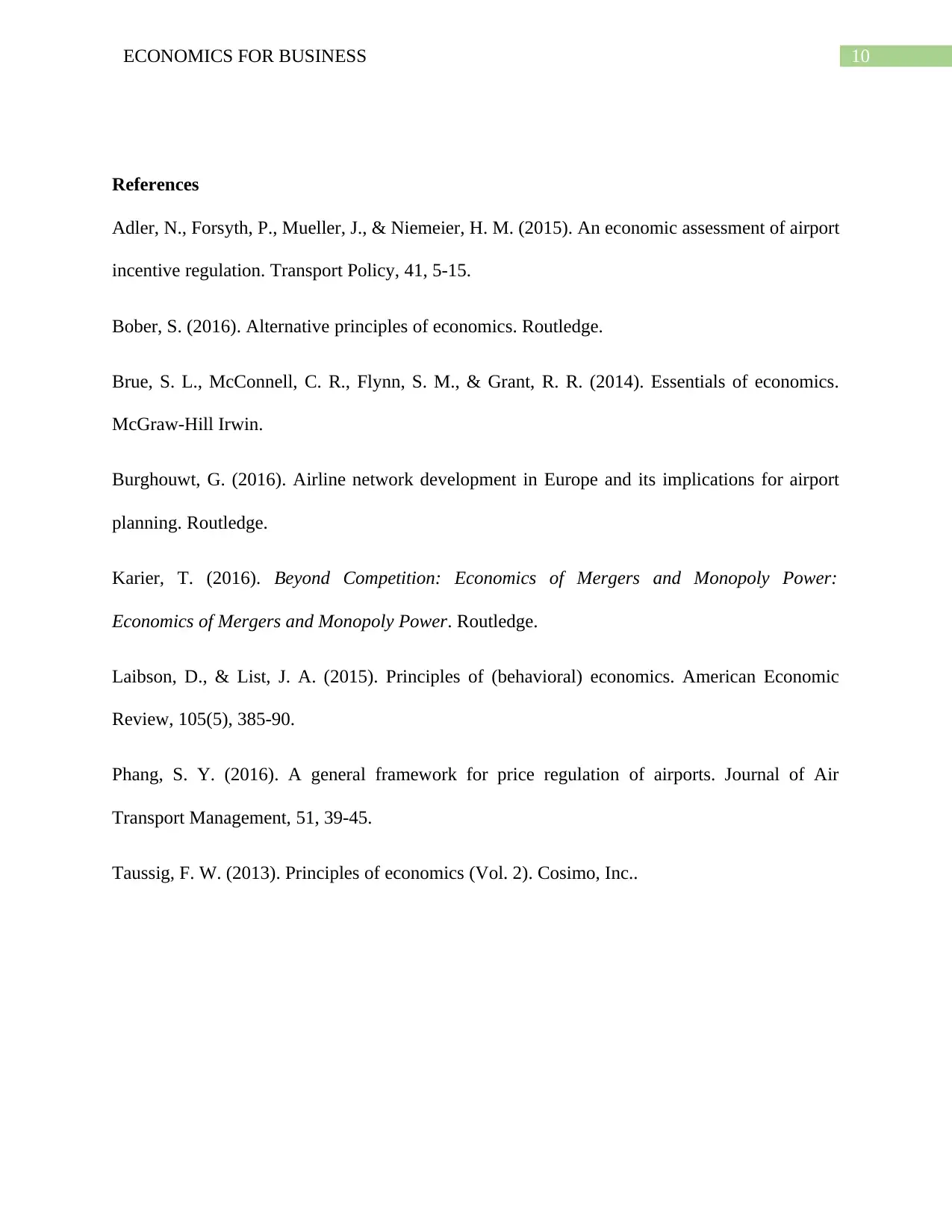
10ECONOMICS FOR BUSINESS
References
Adler, N., Forsyth, P., Mueller, J., & Niemeier, H. M. (2015). An economic assessment of airport
incentive regulation. Transport Policy, 41, 5-15.
Bober, S. (2016). Alternative principles of economics. Routledge.
Brue, S. L., McConnell, C. R., Flynn, S. M., & Grant, R. R. (2014). Essentials of economics.
McGraw-Hill Irwin.
Burghouwt, G. (2016). Airline network development in Europe and its implications for airport
planning. Routledge.
Karier, T. (2016). Beyond Competition: Economics of Mergers and Monopoly Power:
Economics of Mergers and Monopoly Power. Routledge.
Laibson, D., & List, J. A. (2015). Principles of (behavioral) economics. American Economic
Review, 105(5), 385-90.
Phang, S. Y. (2016). A general framework for price regulation of airports. Journal of Air
Transport Management, 51, 39-45.
Taussig, F. W. (2013). Principles of economics (Vol. 2). Cosimo, Inc..
References
Adler, N., Forsyth, P., Mueller, J., & Niemeier, H. M. (2015). An economic assessment of airport
incentive regulation. Transport Policy, 41, 5-15.
Bober, S. (2016). Alternative principles of economics. Routledge.
Brue, S. L., McConnell, C. R., Flynn, S. M., & Grant, R. R. (2014). Essentials of economics.
McGraw-Hill Irwin.
Burghouwt, G. (2016). Airline network development in Europe and its implications for airport
planning. Routledge.
Karier, T. (2016). Beyond Competition: Economics of Mergers and Monopoly Power:
Economics of Mergers and Monopoly Power. Routledge.
Laibson, D., & List, J. A. (2015). Principles of (behavioral) economics. American Economic
Review, 105(5), 385-90.
Phang, S. Y. (2016). A general framework for price regulation of airports. Journal of Air
Transport Management, 51, 39-45.
Taussig, F. W. (2013). Principles of economics (Vol. 2). Cosimo, Inc..
1 out of 11
Related Documents
Your All-in-One AI-Powered Toolkit for Academic Success.
+13062052269
info@desklib.com
Available 24*7 on WhatsApp / Email
![[object Object]](/_next/static/media/star-bottom.7253800d.svg)
Unlock your academic potential
Copyright © 2020–2025 A2Z Services. All Rights Reserved. Developed and managed by ZUCOL.




